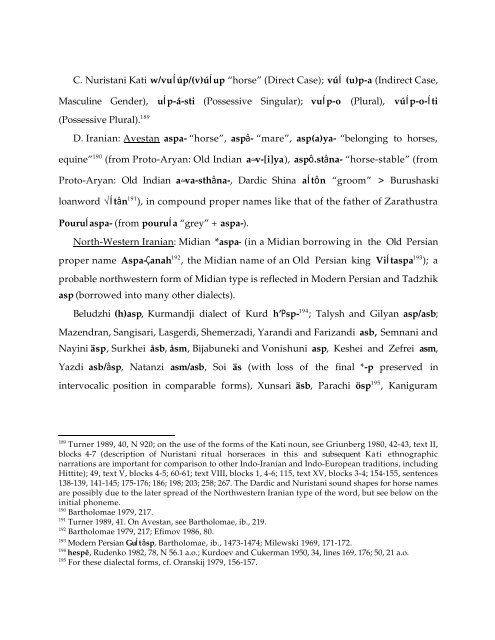Comparative Notes on Hurro-Urartian, Northern Caucasian
Comparative Notes on Hurro-Urartian, Northern Caucasian
Comparative Notes on Hurro-Urartian, Northern Caucasian
Create successful ePaper yourself
Turn your PDF publications into a flip-book with our unique Google optimized e-Paper software.
C. Nuristani Kati w/vuÍúp/(v)úÍup “horse” (Direct Case); vúÍ (u)p-a (Indirect Case,<br />
Masculine Gender), uÍp-á-sti (Possessive Singular); vuÍp-o (Plural), vúÍp-o-Íti<br />
(Possessive Plural). 189<br />
D. Iranian: Avestan aspa- “horse”, aspâ- “mare”, asp(a)ya- “bel<strong>on</strong>ging to horses,<br />
equine” 190 (from Proto-Aryan: Old Indian a≈v-[i]ya), aspô.stâna- “horse-stable” (from<br />
Proto-Aryan: Old Indian a≈va-sthâna-, Dardic Shina aÍtôn “groom” > Burushaski<br />
loanword √Ítân 191 ), in compound proper names like that of the father of Zarathustra<br />
PouruÍaspa- (from pouruÍa “grey” + aspa-).<br />
North-Western Iranian: Midian *aspa- (in a Midian borrowing in the Old Persian<br />
proper name Aspa-Çanah 192 , the Midian name of an Old Persian king ViÍtaspa 193 ); a<br />
probable northwestern form of Midian type is reflected in Modern Persian and Tadzhik<br />
asp (borrowed into many other dialects).<br />
Beludzhi (h)asp, Kurmandji dialect of Kurd h’Psp- 194 ; Talysh and Gilyan asp/asb;<br />
Mazendran, Sangisari, Lasgerdi, Shemerzadi, Yarandi and Farizandi asb, Semnani and<br />
Nayini äsp, Surkhei åsb, åsm, Bijabuneki and V<strong>on</strong>ishuni asp, Keshei and Zefrei asm,<br />
Yazdi asb/âsp, Natanzi asm/asb, Soi äs (with loss of the final *-p preserved in<br />
intervocalic positi<strong>on</strong> in comparable forms), Xunsari äsb, Parachi ösp 195 , Kaniguram<br />
189 Turner 1989, 40, N 920; <strong>on</strong> the use of the forms of the Kati noun, see Griunberg 1980, 42-43, text II,<br />
blocks 4-7 (descripti<strong>on</strong> of Nuristani ritual horseraces in this and subsequent Kati ethnographic<br />
narrati<strong>on</strong>s are important for comparis<strong>on</strong> to other Indo-Iranian and Indo-European traditi<strong>on</strong>s, including<br />
Hittite); 49, text V, blocks 4-5; 60-61; text VIII, blocks 1, 4-6; 115, text XV, blocks 3-4; 154-155, sentences<br />
138-139, 141-145; 175-176; 186; 198; 203; 258; 267. The Dardic and Nuristani sound shapes for horse names<br />
are possibly due to the later spread of the Northwestern Iranian type of the word, but see below <strong>on</strong> the<br />
initial ph<strong>on</strong>eme.<br />
190 Bartholomae 1979, 217.<br />
191 Turner 1989, 41. On Avestan, see Bartholomae, ib., 219.<br />
192 Bartholomae 1979, 217; Efimov 1986, 80.<br />
193 Modern Persian GuÍt âsp, Bartholomae, ib., 1473-1474; Milewski 1969, 171-172.<br />
194 hespê, Rudenko 1982, 78, N 56.1 a.o.; Kurdoev and Cukerman 1950, 34, lines 169, 176; 50, 21 a.o.<br />
195 For these dialectal forms, cf. Oranskij 1979, 156-157.





